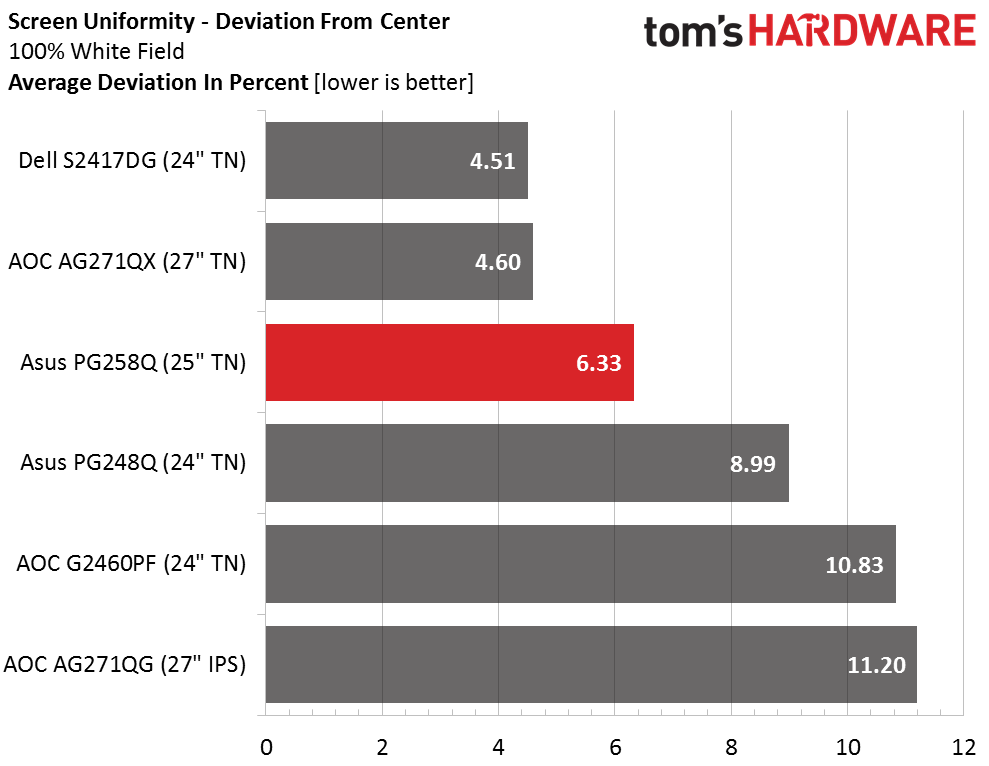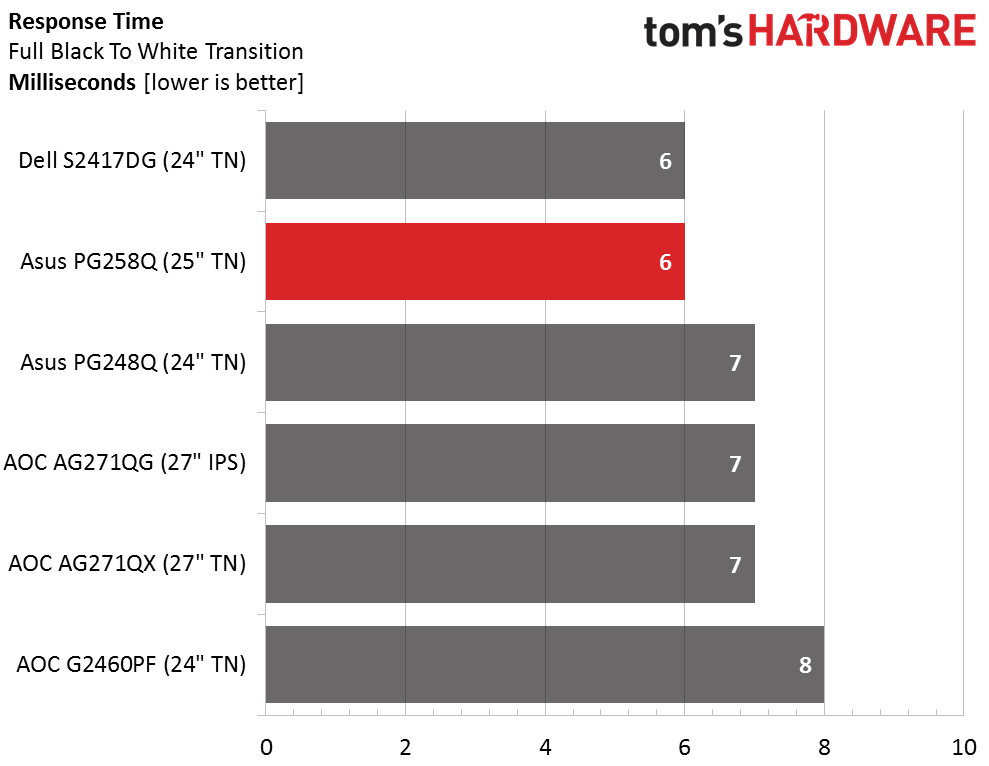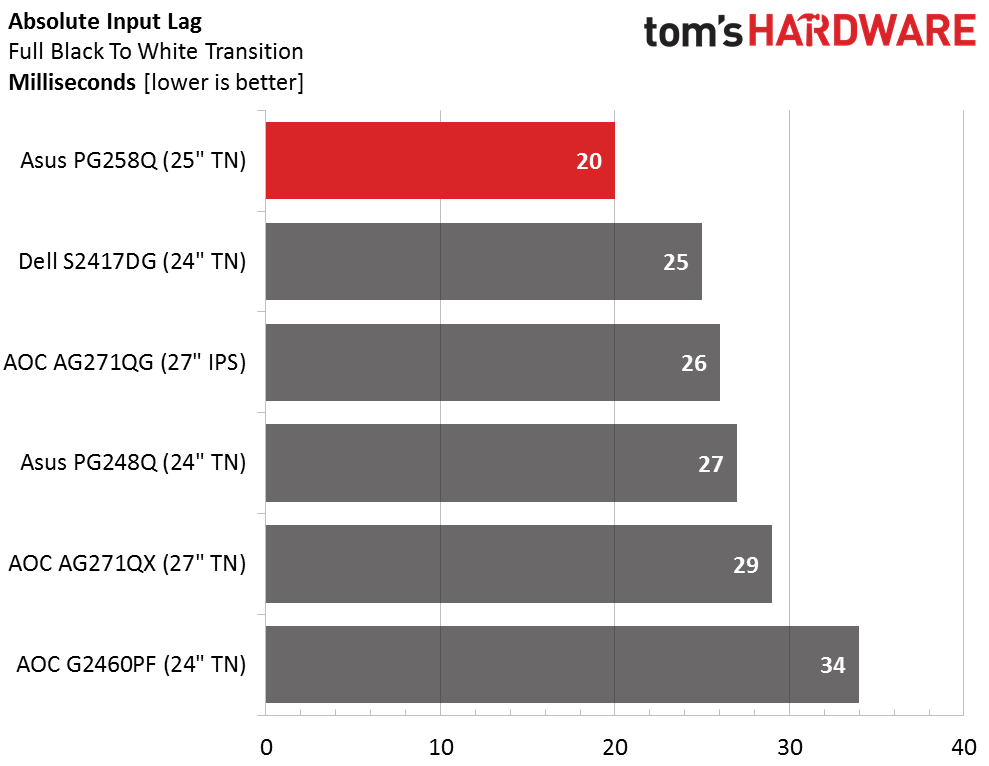Asus ROG Swift PG258Q Monitor Review
Why you can trust Tom's Hardware
Viewing Angles, Uniformity, Response & Lag
Viewing Angles
You won’t mistake the PG258Q for an IPS panel, but if you compare the above photo to those of other TN monitors, you can see that the Asus display retains more detail in darker areas and exhibits a less severe color shift to the sides. The familiar red tint is still there, just not as much. You can even see some detail in the top-down shot. Most others wash this view out completely. It would be great if this kind of speed were possible in a VA panel but apparently, we’re not there yet. For now, TN is the best balance of motion quality and image fidelity.
Screen Uniformity
To learn how we measure screen uniformity, please click here.



TN panels tend to be all over the map in our screen uniformity tests. Some perform well like the PG258Q. Others, not so much. Oh wait, the last place finisher is the IPS-based AG271QG. That shows how sample-specific our field tests are. We’ve already seen plenty of evidence that Asus is using a high quality panel part here. You should be able to buy it with confidence. Not only did both the white and black field results score below 10%, the color test is one of the lowest values in our database. This is one of the reasons for our sample’s high intra-image contrast.
Pixel Response & Input Lag
Please click here to read up on our pixel response and input lag testing procedures.


The PG258Q ties our record for quickest panel response and destroys the mark for overall input lag. If you’re wondering why anyone would turn off G-Sync, this is the reason. Locking the refresh rate at 240Hz means having essentially zero control latency. It’s pretty obvious from our results that refresh rates determine lag, even though the difference is miniscule. Those looking for that last nth degree of performance will find it here. We’d say it can’t get any better, but we know that future technologies will be even faster than this. For now and the foreseeable future, though, the PG258Q is the king of speed.
MORE: Best Computer Monitors
MORE: How To Choose A Monitor
Get Tom's Hardware's best news and in-depth reviews, straight to your inbox.
MORE: All Monitor Content
Current page: Viewing Angles, Uniformity, Response & Lag
Prev Page Color Gamut & Luminance Next Page Gaming With G-Sync
Christian Eberle is a Contributing Editor for Tom's Hardware US. He's a veteran reviewer of A/V equipment, specializing in monitors. Christian began his obsession with tech when he built his first PC in 1991, a 286 running DOS 3.0 at a blazing 12MHz. In 2006, he undertook training from the Imaging Science Foundation in video calibration and testing and thus started a passion for precise imaging that persists to this day. He is also a professional musician with a degree from the New England Conservatory as a classical bassoonist which he used to good effect as a performer with the West Point Army Band from 1987 to 2013. He enjoys watching movies and listening to high-end audio in his custom-built home theater and can be seen riding trails near his home on a race-ready ICE VTX recumbent trike. Christian enjoys the endless summer in Florida where he lives with his wife and Chihuahua and plays with orchestras around the state.
-
apertotes I just don't get it. How can you leave the contrast (arguably the most importante feature on a screen after the resolution) out of the first page of the article? I couldn't care less about the bezel width, but please, state the contrast!Reply -
ahnilated 1080P, *sigh* who wants this anymore! Get me a 4K monitor at 30-32" with good specs and G-Sync that isn't $4000.Reply -
dstarr3 Reply19637653 said:1080P, *sigh* who wants this anymore! Get me a 4K monitor at 30-32" with good specs and G-Sync that isn't $4000.
Because that's the reality of GPUs at the moment. GPUs can get you a solid 4K/60 or a solid 1080p/144. You're not going to get 4K/144 in any modern games on any PC at the moment (unless you're only playing 20-year-old games). So there's not a lot of sense in wanting to invest in a 4K/144 monitor now, only in anticipation of when GPUs can finally push that many pixels, because you'll be wasting the monitor while you wait, and when such GPUs finally do arrive, the monitors will be better and cheaper. -
Rosanjin Do we know if this monitor is 3dVision capable?Reply
I would assume so, but I've learned some very expensive lessons by making purchases based on assumptions. : / -
ahnilated Reply19637717 said:19637653 said:1080P, *sigh* who wants this anymore! Get me a 4K monitor at 30-32" with good specs and G-Sync that isn't $4000.
Because that's the reality of GPUs at the moment. GPUs can get you a solid 4K/60 or a solid 1080p/144. You're not going to get 4K/144 in any modern games on any PC at the moment (unless you're only playing 20-year-old games). So there's not a lot of sense in wanting to invest in a 4K/144 monitor now, only in anticipation of when GPUs can finally push that many pixels, because you'll be wasting the monitor while you wait, and when such GPUs finally do arrive, the monitors will be better and cheaper.
The reason you won't get it is because the GPU's won't do it, not because the games won't. Game developers want to make more realistic games but the GPU's are lagging way behind. Nvidia hasn't had any real competition for many years so there was no need for them to push to 4K gaming at 144Hz or higher. I am hoping AMD's cards will force Nvidia to get off their buts as it seems the consumers aren't going to pull their money from Nvidia until Nvidia gets back on the ball. -
Geo Matrix I agree with AHNILATED! DSTARR3 says, "Because that's the reality of GPUs at the moment". I say let's have some serious change! Asus and Nvidia are "milking the cow" with these old relics. Everything is now going 4K, 6K and 8K. It's time to stop milking the cow and people's wallets and put out the new technology. It's 2017, not 1980. We all know the new tech is already here.Reply -
dstarr3 Based on the performance bump we saw from the 1080 Ti, I don't think it's fair to say that nVidia's slouching when it comes to GPU performance. Pricing, sure, they could use more competition. But something like 4K/144 is a seriously enormous amount of processing to do. The DisplayPort and HDMI interfaces themselves had to be updated to transfer that much data. I'm amazed we got 4K/60 out of GPUs as quickly as we did. Give it another generation and we should be hovering around 4K/144. But you ask why there's no 4K/144 gaming monitors coming out yet, and this is why. There aren't any 4K/144 GPUs out yet, either. And it's not because any particular company is stagnating. It's because pushing that many pixels to a monitor is a huge, huge task.Reply -
Deadshot-89 I use an Eizo EV 2336W. It has incredibly accurate and incredibly deep and vidid colors right out of the box. It also has a very deep picture and for an IPS screen very deep blacks. And to top it all off, it has extremely nice viewing angles, no color-shifts and it retains a ton of brightness at very steep angles. Motion performance is very OK for a 60 Hz screen.Reply
My current hardware isn't really capable of producing more than a reliable 1080p60. (GTX 970, i5-4590). So I see no reason to switch to a higher res screen or higher refresh rate screen.
